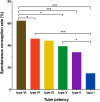Spontaneous conception outcome in infertile women after four-dimensional hysterosalpingo-contrast-sonography
- PMID: 33081754
- PMCID: PMC7574424
- DOI: 10.1186/s12884-020-03315-x
Spontaneous conception outcome in infertile women after four-dimensional hysterosalpingo-contrast-sonography
Abstract
Background: Four-dimensional hysterosalpingo-contrast sonography (4D-HyCoSy) is the preferred way for evaluating fallopian tubal patency and it associated with higher rate of spontaneous conception. However, Few studies have evaluated the influencing factors of spontaneous conception in 4D-HyCoSy and suggested ways to choose treatment options after 4D-HyCoSy. The study was to evaluate the correlation between spontaneous conception outcome and the patients' clinical characteristics as well as tubal patency in infertile women to provide reference on ways to manage the patient after 4D-HyCoSy.
Methods: This was a retrospective study and analysis of two hundred and eighty three (283) infertile patients who underwent a 4D-HyCoSy between December 2014 and October 2017 in our center. Eligible patients were those whose partners semen parameters were normal when based on World Health Organization (WHO) criteria, and had spontaneous conception without clinical interventions after 4D-HyCoSy.
Result(s): One hundred and sixteen patients (40.9%) conceived spontaneously and the mean conception time was (8.8 ± 0.3) months. Within a year after 4D-HyCoSy, the spontaneous conception rate was highest in type VI(62.5%), followed by type IV (46.2%), type III (44.4%), type V (39.4%), type II (33.9%) and type I (14.8%). With Cox regression analysis, two factors associated with spontaneous conception outcome appeared to increase spontaneous conception rate: patients with type IV or type VI tubes and duration of infertility less than 2 years. The age, type of infertility, multiparas, history of pelvic surgery, history of uterine cavity operation, uterine fibromyomata and polycystic ovary were unrelated to spontaneous conception outcome after 4D-HyCoSy.
Conclusion(s): This study showed that some infertile women could succeed in spontaneous conception after 4D-HyCoSy. Hence, We recommend the usage of 4D-HyCoSy as first line for tubal patency test and infertile patients should be advised to accept 4D-HyCoSy examination as soon as possible. Expectant treatment of about 8-9 months is reported to be feasible for infertile women whose 4D-HyCoSy findings showed one tube patency or poor patency. Alternatively, an immediate clinical intervention is recommended for those with bilateral obstructed tubes .
Keywords: Hysterosalpingo contrast; Infertility; Sonography; Spontaneous conception; Tubal patency.
Conflict of interest statement
The authors declare that they have no conflicts of the interest and nothing to disclose.
Figures





Similar articles
-
Assessment of Fallopian Tube Fimbria Patency With 4-Dimensional Hysterosalpingo-Contrast Sonography in Infertile Women.J Ultrasound Med. 2017 Oct;36(10):2061-2069. doi: 10.1002/jum.14244. Epub 2017 May 24. J Ultrasound Med. 2017. PMID: 28543598
-
Combined Real-Time Three-Dimensional Hysterosalpingo-Contrast Sonography with B Mode Hysterosalpingo-Contrast Sonography in the Evaluation of Fallopian Tube Patency in Patients Undergoing Infertility Investigations.Biomed Res Int. 2019 Jun 3;2019:9408141. doi: 10.1155/2019/9408141. eCollection 2019. Biomed Res Int. 2019. PMID: 31275995 Free PMC article.
-
Hysterosalpingo-Contrast Sonography With Four-Dimensional Technique for Screening Fallopian Tubal Patency: Let's Make an Exploration.J Minim Invasive Gynecol. 2017 Mar-Apr;24(3):407-414. doi: 10.1016/j.jmig.2016.12.011. Epub 2016 Dec 27. J Minim Invasive Gynecol. 2017. PMID: 28034794
-
Two-dimensional hysterosalpingo-contrast-sonography compared to three/four-dimensional hysterosalpingo-contrast-sonography for the assessment of tubal occlusion in women with infertility/subfertility: a systematic review with meta-analysis.Hum Fertil (Camb). 2022 Feb;25(1):43-55. doi: 10.1080/14647273.2020.1769204. Epub 2020 Jun 2. Hum Fertil (Camb). 2022. PMID: 32484066
-
Contrast ultrasonography for tubal patency.J Minim Invasive Gynecol. 2014 Nov-Dec;21(6):994-8. doi: 10.1016/j.jmig.2014.05.017. Epub 2014 Jun 6. J Minim Invasive Gynecol. 2014. PMID: 24910933 Review.
Cited by
-
Perinatal outcomes of twin pregnancies in women with a unicornuate uterus.Arch Gynecol Obstet. 2025 Jul;312(1):229-236. doi: 10.1007/s00404-025-08001-x. Epub 2025 Mar 21. Arch Gynecol Obstet. 2025. PMID: 40119210 Free PMC article.
-
Efficacy of 4-dimensional hysterosalpingo-contrast sonography and X-ray hysterosalpingography in infertility.Pak J Med Sci. 2025 Jan;41(1):151-156. doi: 10.12669/pjms.41.1.10743. Pak J Med Sci. 2025. PMID: 39867762 Free PMC article.
-
Evaluation of tubal patency by hysterosalpingo-contrast Sonography (HyCoSy): Controversies, dilemmas and considerations.Heliyon. 2023 Jun 28;9(7):e17461. doi: 10.1016/j.heliyon.2023.e17461. eCollection 2023 Jul. Heliyon. 2023. PMID: 37539233 Free PMC article. Review.
-
Spontaneous Pregnancy after 4D-Hysterosalpingo-Sonography (HyCoSy) in the Same Menstrual Cycle: A Case Report and an Updating Review of the Current Literature regarding the Positive Impact of Tubal Flushing Effect on Fertility.Case Rep Obstet Gynecol. 2024 Jun 11;2024:7774854. doi: 10.1155/2024/7774854. eCollection 2024. Case Rep Obstet Gynecol. 2024. PMID: 38962290 Free PMC article.
-
Comparison of Effectiveness as well as Advantages and Disadvantages of Different Dimensions of Hysterosalpingo-Contrast Sonography for Diagnosis of Lesions Associated with Female Infertility.Comput Math Methods Med. 2022 Sep 17;2022:7508880. doi: 10.1155/2022/7508880. eCollection 2022. Comput Math Methods Med. 2022. Retraction in: Comput Math Methods Med. 2023 Dec 13;2023:9757648. doi: 10.1155/2023/9757648. PMID: 36164612 Free PMC article. Retracted.
References
-
- Hajishafiha M, Zobairi T, Zanjani VR, Ghasemi-Rad M, Yekta Z, Mladkova N. Diagnostic value of sonohysterography in the determination of fallopian tube patency as an initial step of routine infertility assessment. J Ultrasound Med. 2009;28(12):1671–1677. doi: 10.7863/jum.2009.28.12.1671. - DOI - PubMed
MeSH terms
Substances
Grants and funding
LinkOut - more resources
Full Text Sources
Medical

